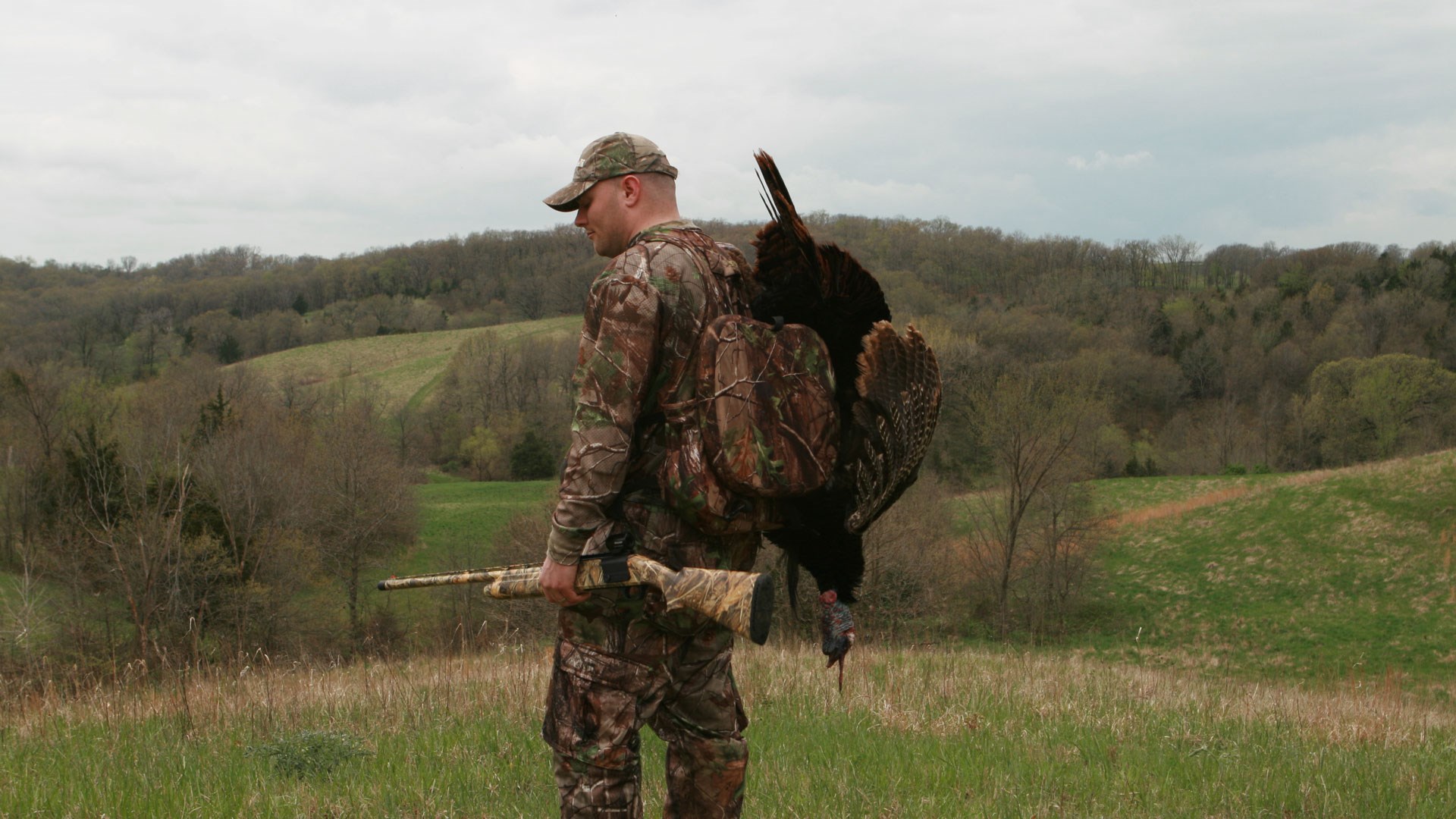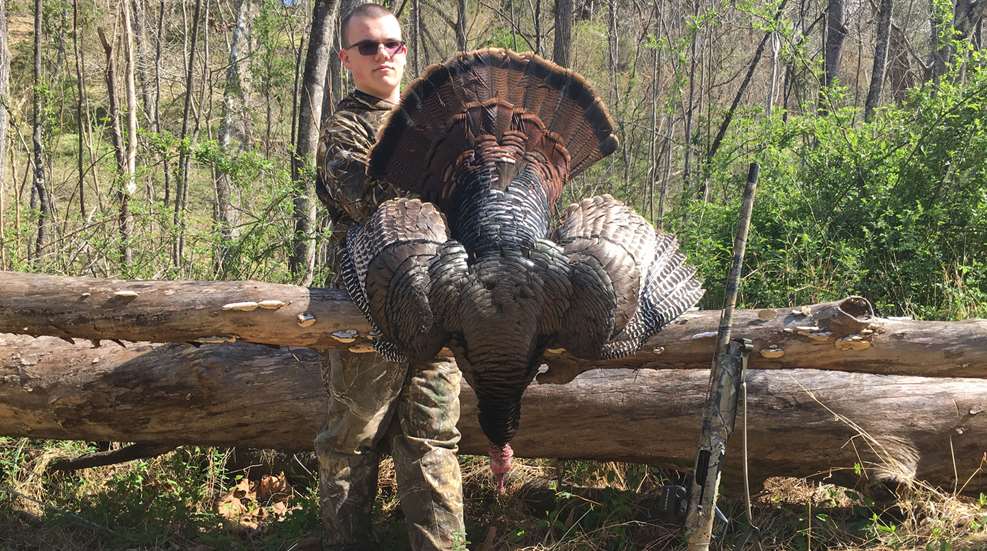
Upon exiting the vehicle, I was instantly greeted by the recurring gobbling of a lovesick tom only a few hundred yards away. The conditions elicited a familiar, euphoric feeling; I would close the deal on the boisterous bird. Why? Déjà vu. A few years earlier, I notched a Virginia “Spring Only” turkey tag under virtually identical circumstances.
After loading my gun and a last check of my gear, I began my methodically planned descent toward the bottom of the gulch, opposite of the perching gobbler. Positioned high on a ridge at the edge of the neighbor’s property, the tom had a mostly unobstructed view of the valley below. I used the terrain and flora to my advantage.
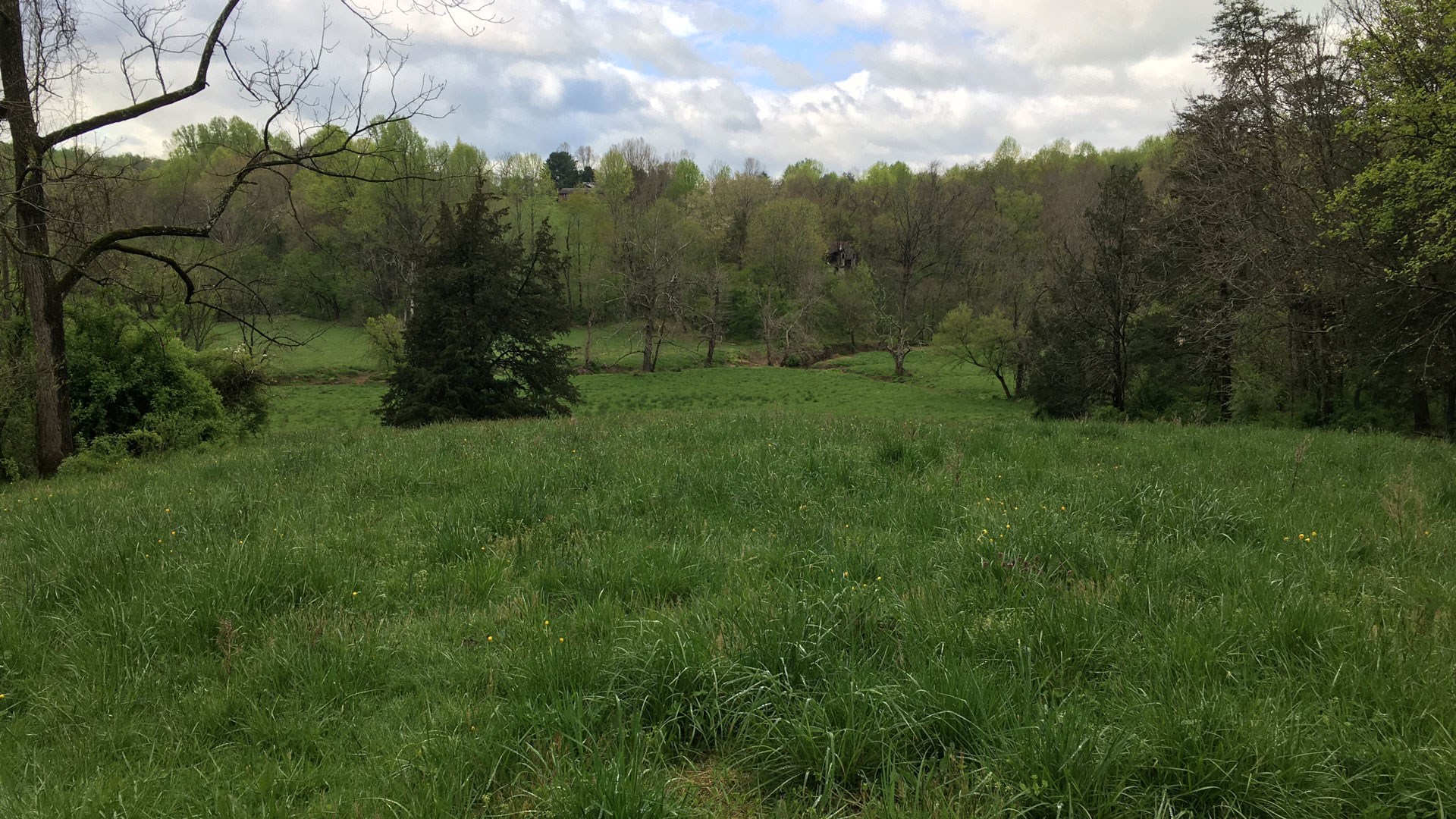
If history were repeated, upon exiting the roost tree the longbeard would fly across the property line, land in the clearing immediately forward of my position, catch sight of my Gobstopper hen decoy, and, while displaying his plumage, close the distance for a shot. An immediate response to my Primos “The Karen” mouth call set the plan into motion, and a second cemented it. It was “go time”; there was no turning back or changing tactics now.
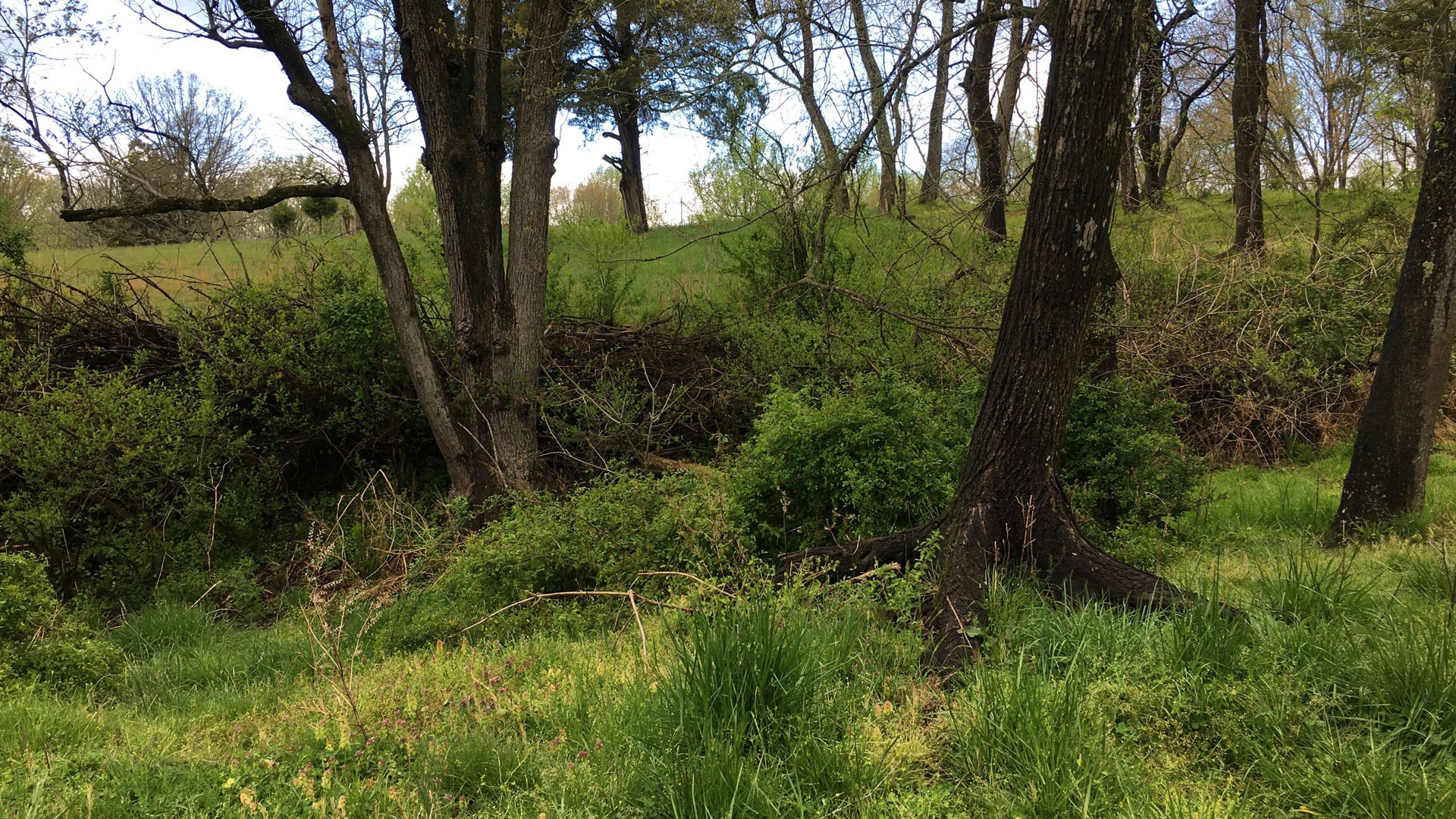
With the deke situated in the “fatal funnel” between his landing zone and the hill on which I nestled among the assorted vegetation and rock outcroppings, it was now a waiting game. It didn’t take long. A few additional yelps—which were enthusiastically answered—weren’t needed but spurred the inevitable. Then he fell silent. Having hunted turkeys for more than three decades, I easily interpreted its meaning—he’s preparing to come in, or already in route.
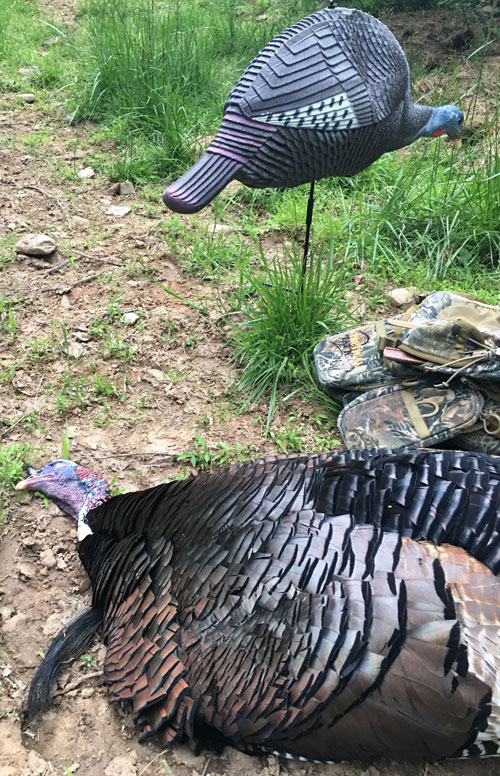
The sounds stemming from a few wing beats and gliding, as well as a visual of his landing, confirmed my hunch. Best of all, the animated bird was already within 40 yards and in view of the decoy. With the safety off, I patiently waited for the now-strutting gobbler to clear a dead, fallen cedar tree while easing toward his hen. He didn’t make it.
If you’re still reading, or the abovementioned hunt from my 2020-21 season appealed to you, then you’re at least considering participating in a spring turkey hunt. That’s phenomenal! Getting started isn’t difficult, nor does it have to be expensive. You also don’t have to be an “expert” to find success. As with any undertaking, there’s essential foundational knowledge, and the rest will be learned—and refined—over time as you match wits with tough toms. In the subsequent sections you’ll learn what is needed to become a turkey hunter, gaining essential understanding in the process.
Gear
Don’t believe that you need a truckload of equipment to notch your tag—you don’t. But there are some non-negotiables, as well as items that are handy. Obviously, the first is a firearm.
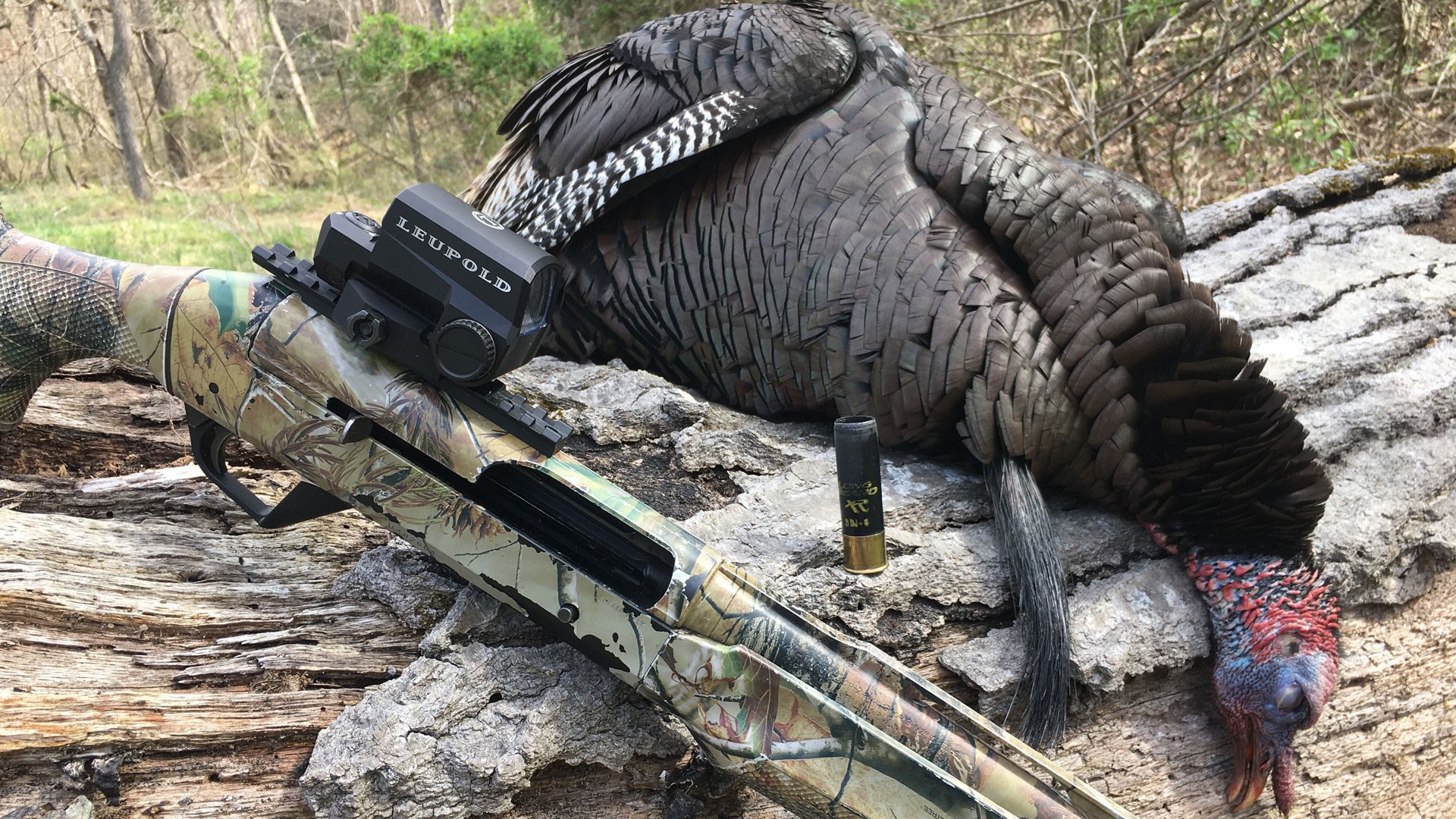
Some states, such as Virginia, allow the use of rifles for spring turkey hunting; however, many don’t, and honestly, even if legal, they’re usually not the best tool for the job. Shotguns get the nod. Unlike other types of wing-shooting, though, turkey hunters are often afforded a single, aimed shot at a relatively small (and seldom static) target—the head and neck. Given the bird’s proximity to the hunter, as well as the scarcity of shots, most shotguns—especially when loaded with today’s most advanced shells—are perfectly serviceable.
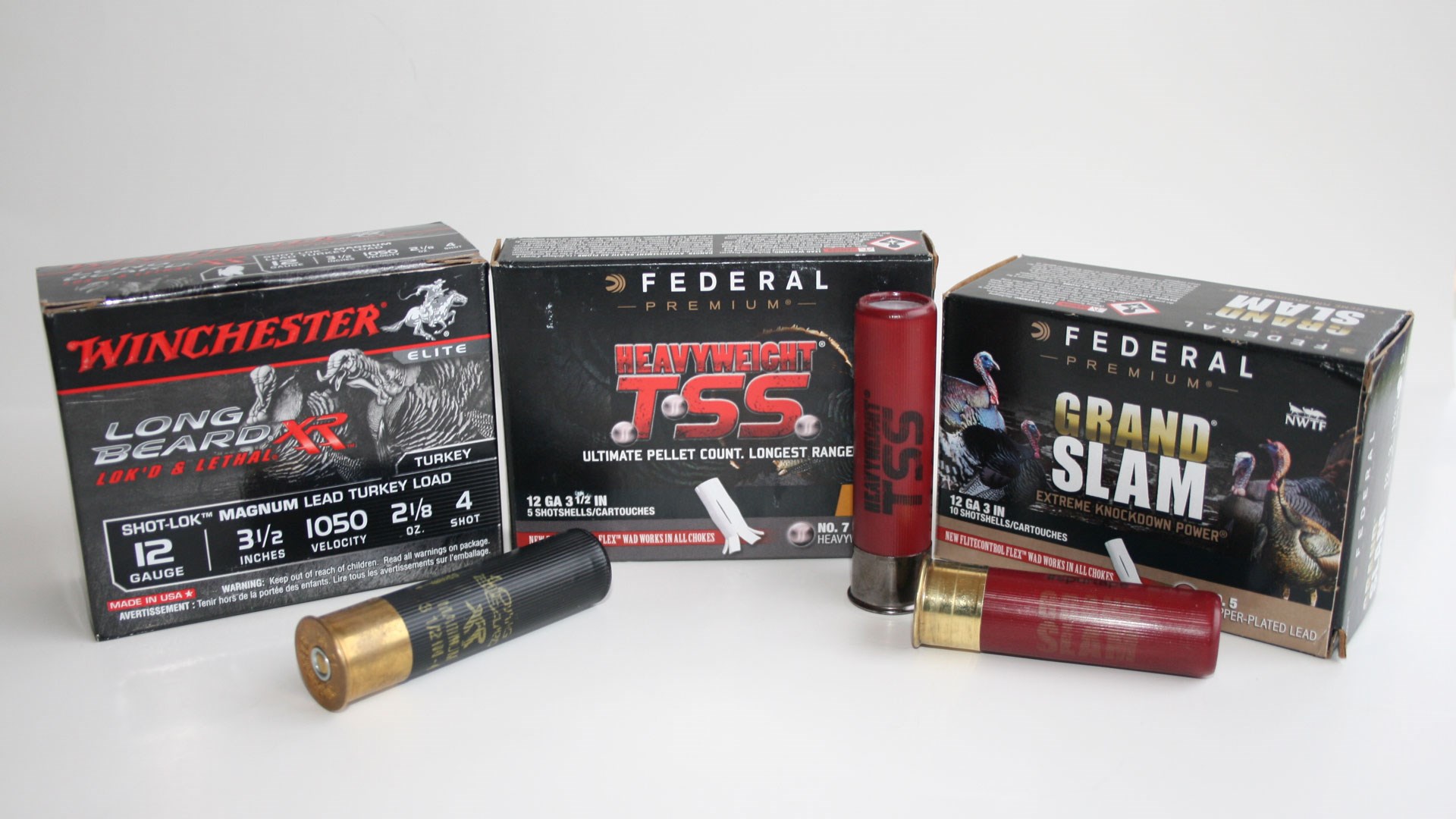
More important than action type—i.e., single-shot, over/under, side-by-side, pump-action and semi-automatic—is the constriction of the scattergun’s choke(s). Usually stamped on the barrel(s) of models that don’t accept choke tubes, or the choke tubes themselves of those that do, a “Full” or “tighter” constriction is appropriate. Why? To ensure a humane kill, you want as many pellets delivered to the head and neck as possible, and “tight” constrictions produce patterns with dense cores. Most new shotguns come standard with multiple choke tubes, of which one is usually “Full.” There are numerous aftermarket choke tube manufacturers that make dedicated turkey-hunting chokes in an array of constrictions. The adage “too much of a good thing” holds true with chokes; extra-tight constrictions can, at times, negatively affect patterns with certain loads, and they can make it easier to miss a gobbler that approaches especially close.
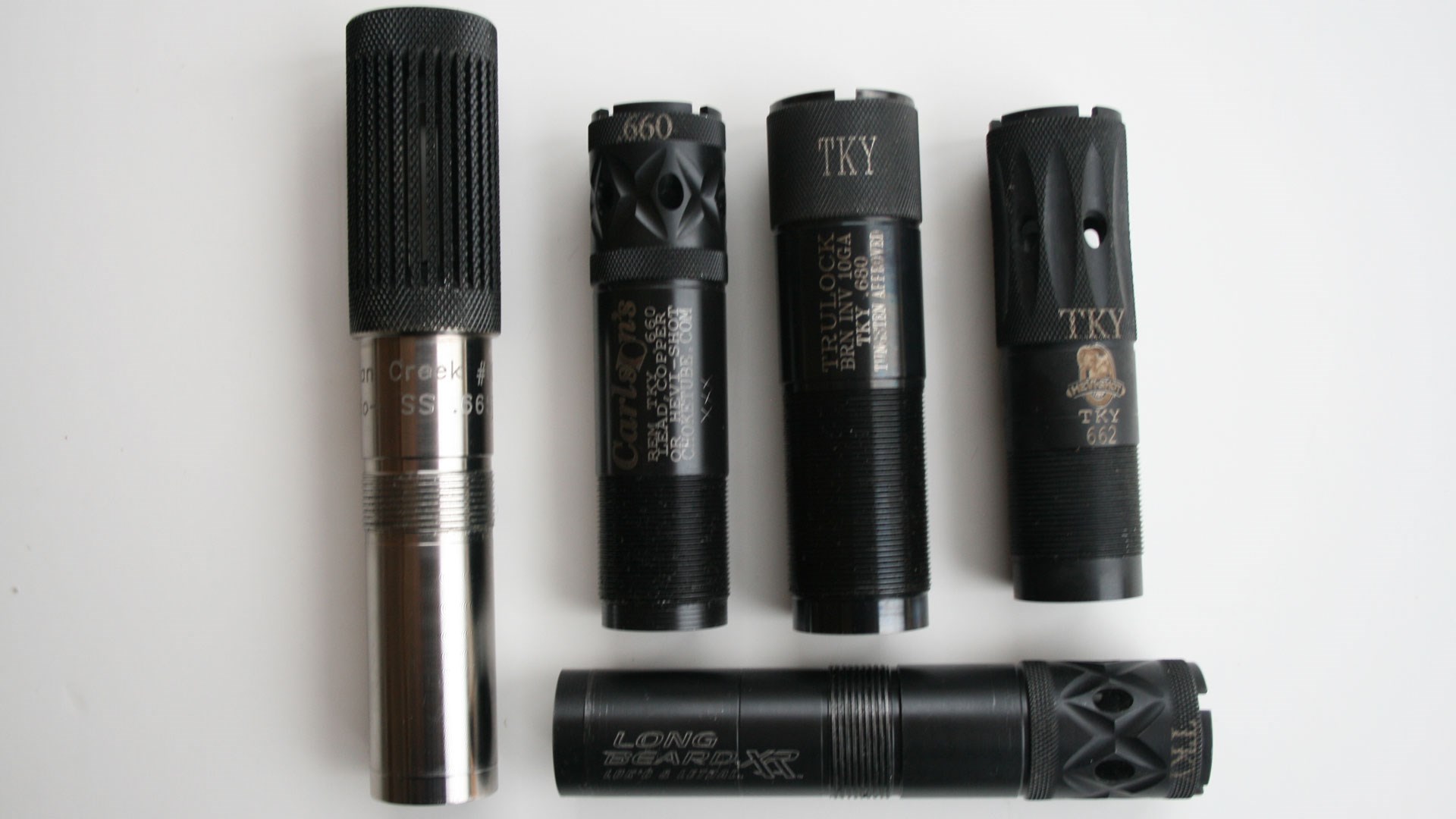
How can you establish the pattern that your shotgun/choke/shell will produce, or if the firearm even hits where it’s aimed? You need to spend time at the range patterning it. Suspend a sizeable sheet of paper—I use inexpensive, remnant wrapping paper—with a turkey target (I prefer TruGlo’s reactive Tru-See) and, at 30 yards, shoot the target from a solid rest. Note the distribution of pellets and location of the pattern’s core, which may be centered … or not. There’s no consensus on the number of pellets that should strike the vitals. Some hunters say three, for others it’s five, and for yet others it’s well above that. Just know that more is better, and redundancy is a good thing. You want no doubt that you’ll incapacitate the bird, even if it moves or your aim is less than true. Repeat the process. Multiple targets at a given distance will better illustrate the average pattern. Next, move back in 10-yard intervals and continue testing. At some distance you’ll encounter insufficient patterns; remember this range and, in the field, stop well short of it.
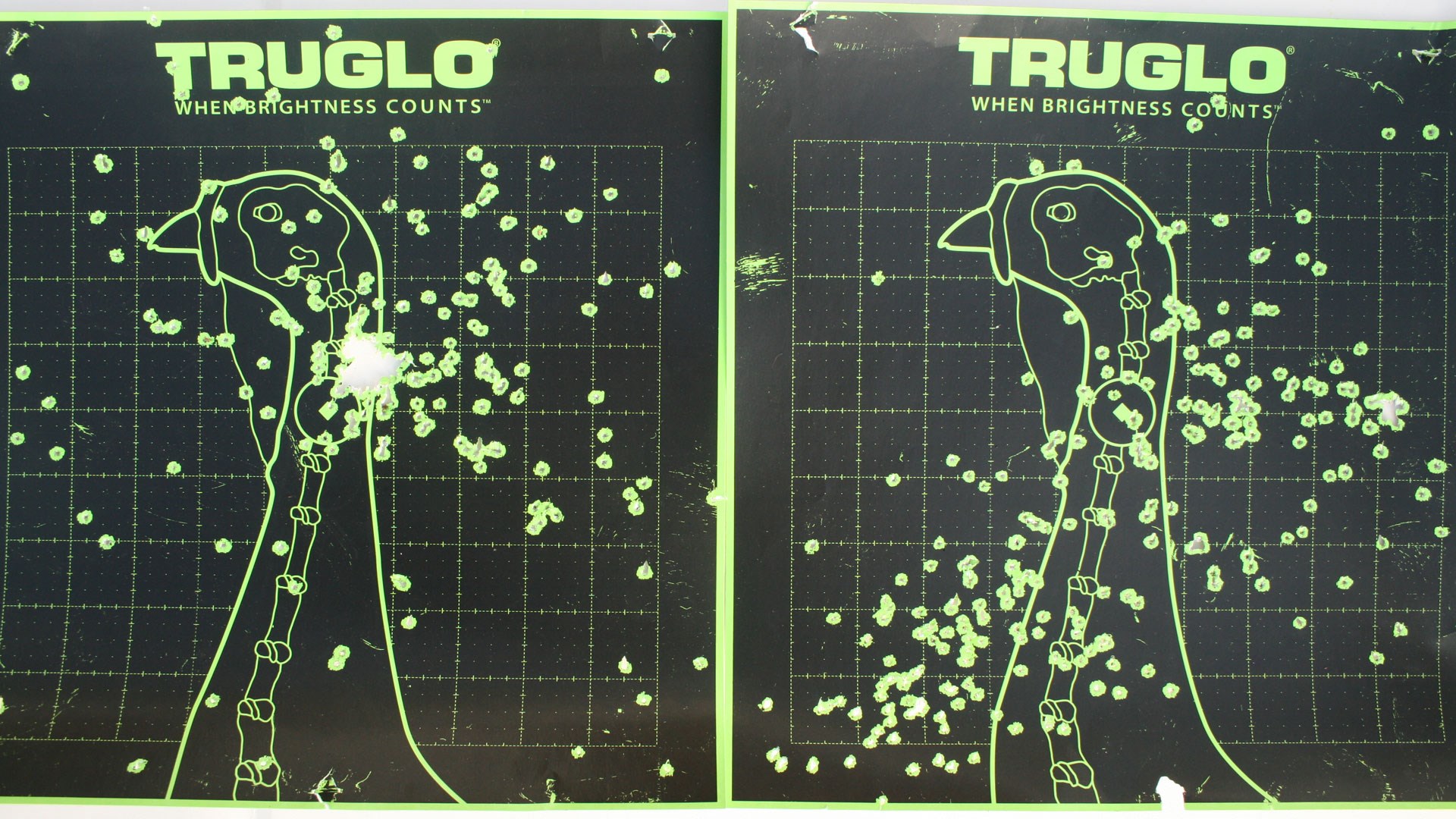
As an aside, to help better aim your shotgun, you can add a red-dot/reflex-style sight. I recommend this, as it makes precise delivery of the pattern’s core on the vitals very easy. It also speeds sighting.
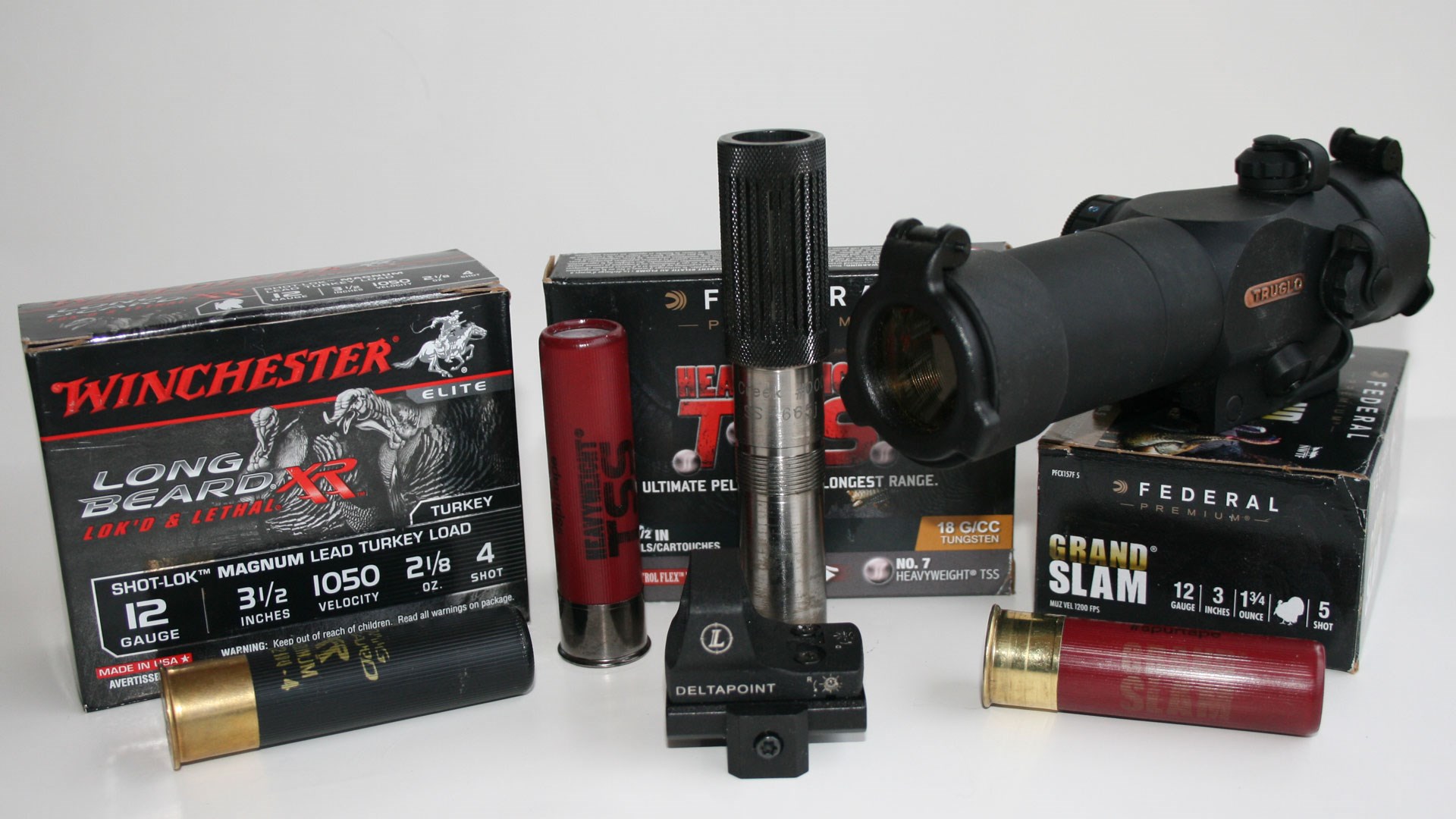
As for gauge, 10-, 12-, 16-, 20- and 28-gauge, as well as .410-bore, can kill a turkey; don’t let anyone tell you otherwise. A pellet fired from the barrel of a 12-gauge is no more powerful than one from a .410 if the muzzle velocities are identical. The primary difference between the larger gauges and smaller ones is the shot charge (i.e., number of pellets) each can send downrange. More shot aids hit probability but also increases felt recoil. Most load development is focused on 12-gauge and, increasingly, 20-gauge, so there are a more diverse range of offerings there.
When selecting ammunition, the foremost considerations are what is legal, affordable (to you), and will it meet your expectations (for patterns and range). If lead shot is prohibited, you’ll need to choose from tungsten super shot (TSS), Hevi-Shot, bismuth or one of the other lead-free options, though the former is popular with ardent turkey hunters due to its unparalleled penetration and tight patterns at jaw-dropping ranges. The cost is high, though. TSS loads are available from Federal, Browning, Remington, Apex Ammunition and Fiocchi, among others. Lead loads are still a great option for all but the longest shots and are economically friendly. For those wanting a mixture of the abovementioned shot types, go with Federal 3rd Degree TSS.
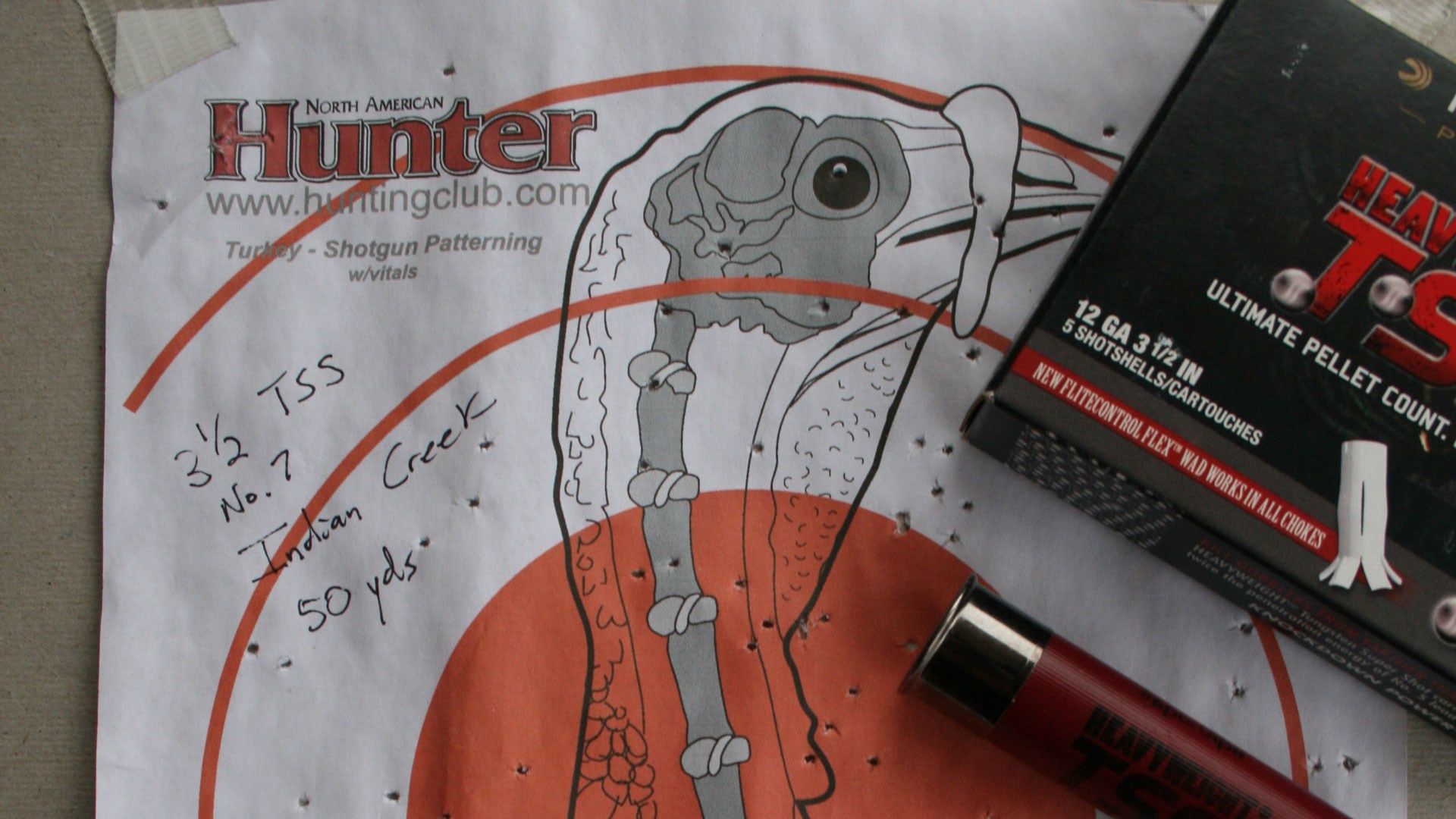
Consult your game laws before selecting shot size. The advent of TSS, which has a density of 18.1 g/cc (versus lead’s 11.34 g/cc), enables you to use a smaller shot and achieve comparable downrange performance. Still, the small shot sizes aren’t legal universally. Game laws can also prevent using shot that is too large. In general, No. 4, 5 and 6 shot are the most popular and practical shot sizes. No. 4s will give you fewer but larger pellets for greater reach and impact while the contrary is true of 6s. No. 5 shot is a good compromise. At most practical ranges, a turkey won’t know the difference. As for TSS, companies load shot as small as No. 10 and even some with multiple sizes, though most are between No. 7 and 9. I prefer No. 7; I’ve never encountered a more lethal pellet for turkeys.
Beyond the firearm and ammunition, you’ll need a call or, preferably, calls. Like humans, turkeys are individualist and what entices one might not work for another. I often carry two to three diaphragm (or mouth) calls—Primos “The Karen” and HS Strutt Cutt’n 2.5 and The Fang—as well as a box call (Primos Bamboozled), and glass (HS Strut Lil’ Deuce). All three of my longbeards, as well as that of my son, fell to the former last season.
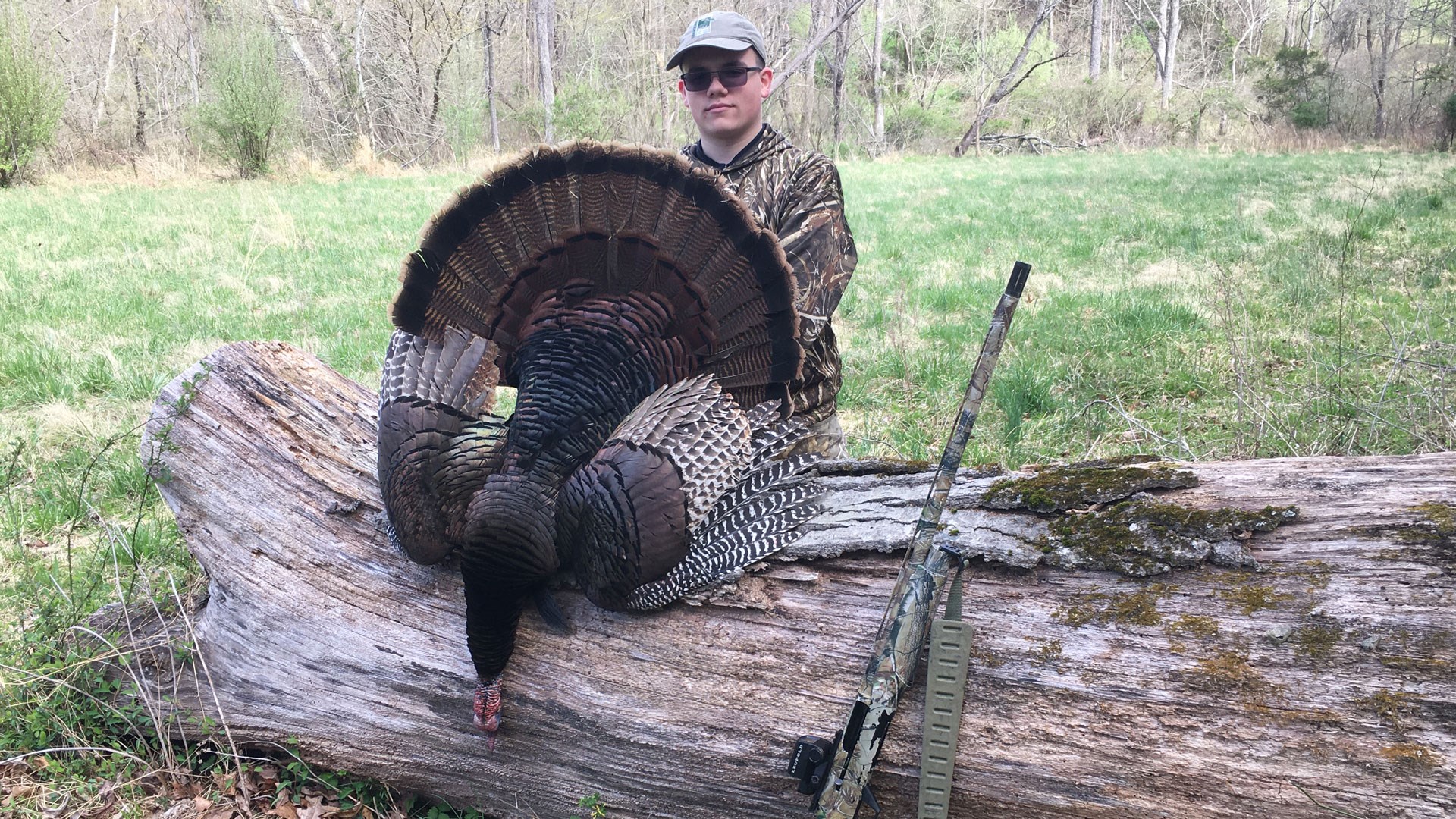
Although I have had instances where a box or glass/slate/pot call outperform a mouth call, mostly I use the increased volume they offer to fire up a bird (especially on windy days) and get it heading my direction, where I finish it with a mouth call. Diaphragm calls are tougher to master than their handheld counterparts (it took me years to even keep it in my mouth without gagging), but they’re indispensable once the gobbler is in sight and you cannot move. However, find what works best for you and practice, practice, practice. Taking it out of the package and straight into the woods will cost you birds. You get out of the hunt what you put into preparation.
Decoys are nice to have on-hand, but not essential. Realistic ones are especially useful for pulling in wary toms, but more important is the attention they draw. As the bird is focusing on the deke, which it believes is the source of the call, it’ll be less likely to spot you. I always have a collapsible hen decoy with me, but whether I’ll deploy it depends on the bird’s reaction to my calling. If a longbeard is literally running in and I risk getting seen, then I don’t; however, if there are multiple birds responding, an opportunity for a protracted hunt, or I need to pull a bird across property lines, then it goes out; the risk is worth the reward. On private land I sometimes add a jake decoy to aggravate a dominant gobbler into approaching; however, I don’t use it on state or federal land due to other hunters.
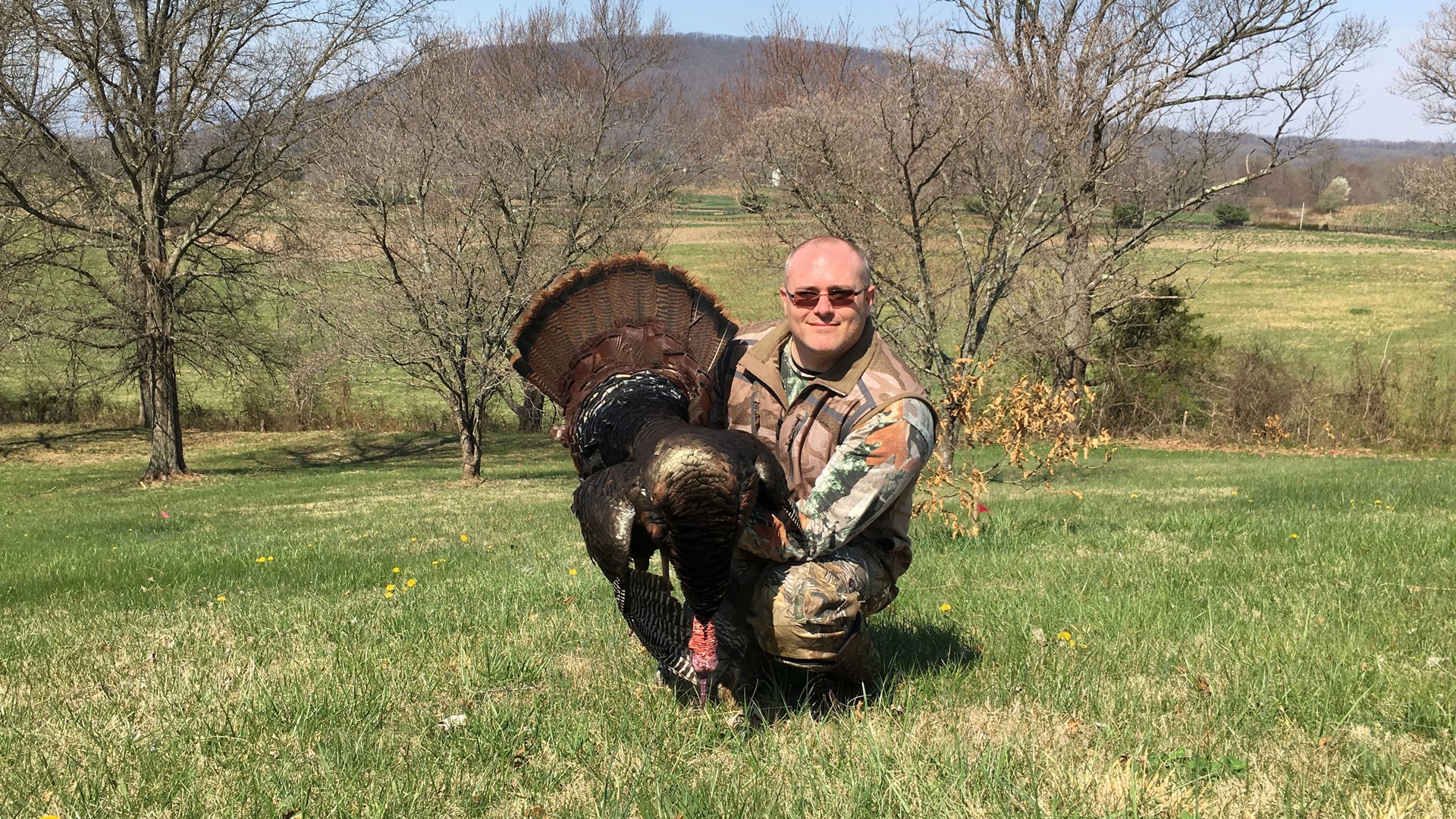
As for camouflage, don’t get caught up in the hype. Remaining motion free and in the shadows is more important than high-dollar concealment. Patterns aren’t critical; you can buy whatever somewhat resembles the flora you’re hunting. I purchase based on price, and the limit of longbeards I kill yearly don’t seem to mind at all.
Other items that accompany me into the turkey woods are shooting sticks (which will support the weight of your shotgun while you’re waiting for the bird to arrive); pruners (to cut brush and build an improvised blind quickly); extra shells; rangefinder; binocular; gloves; face mask; snake-proof boots (or chaps); an HS Strut Super Light Portable Ground Blind; and snacks and sports drink/water. You might add a Thermacell if you’re in an area with a lot of mosquitoes. A quality turkey vest will help keep the items accessible and prevent them from jostling, making noise. It’s also great for carrying out a gobbler.
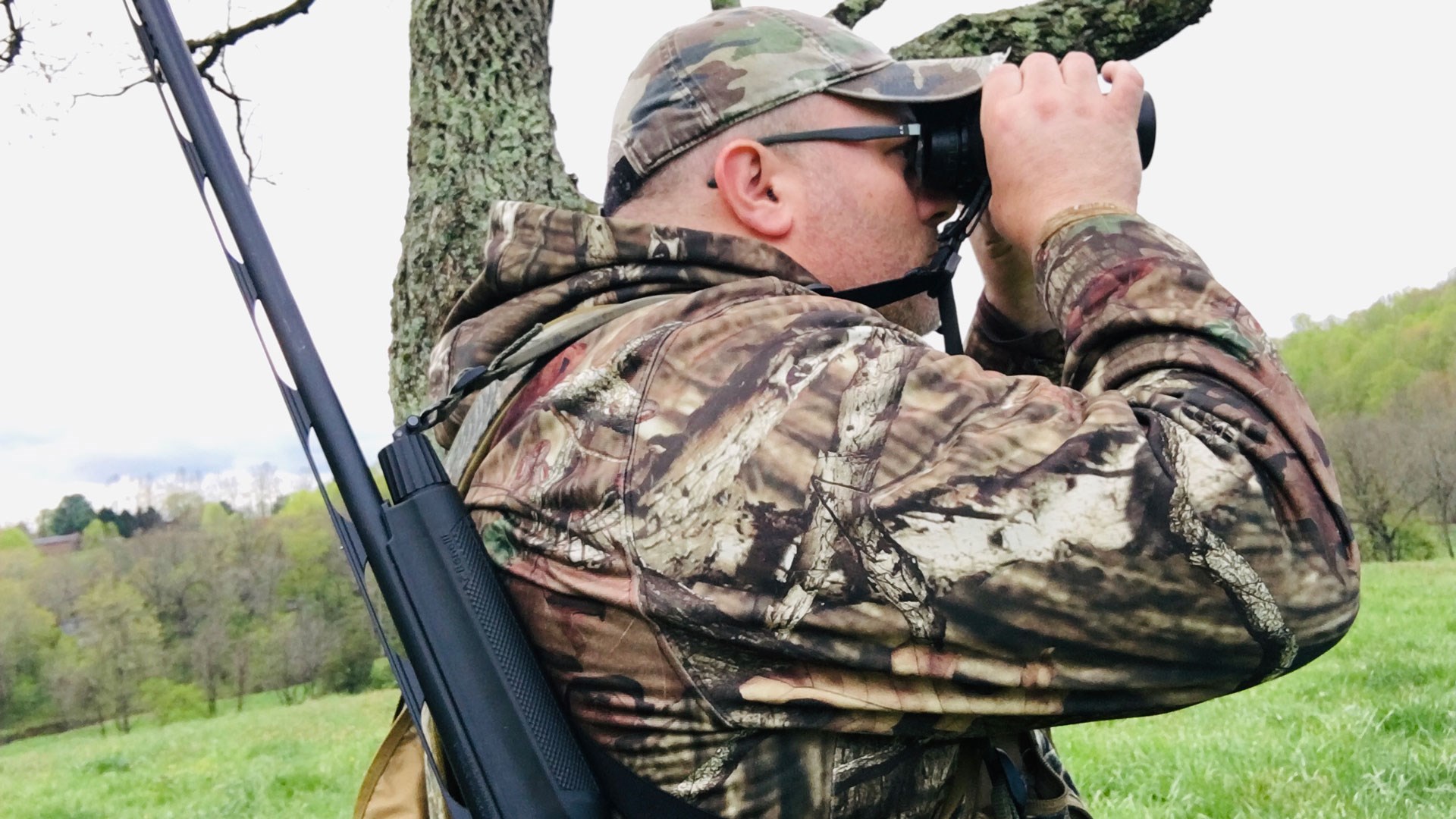
Habits & Habitat
Consistently tagging a spring gobbler requires an understanding of the quarry’s habits and its habitat. For instance, as you read in the opening section, the longbeard originated on a neighbor’s ridge but was killed on our property. What made it possible was a full understanding of the turkey’s behavior in that area and the terrain. While the tom religiously roosted in the stand of hardwoods, its days were spent on the creek bottom and hillside where I was. There, he unfailingly followed a flock of hens through the cedars and autumn olives and across the openings. And thanks to the cattle grazing the land, the grass was short, so it was a perfect location for the gobbler to strut. I hadn’t happened onto this spot haphazardly; rather, I learned about it through previous scouting and hunting trips, and the knowledge paid off.
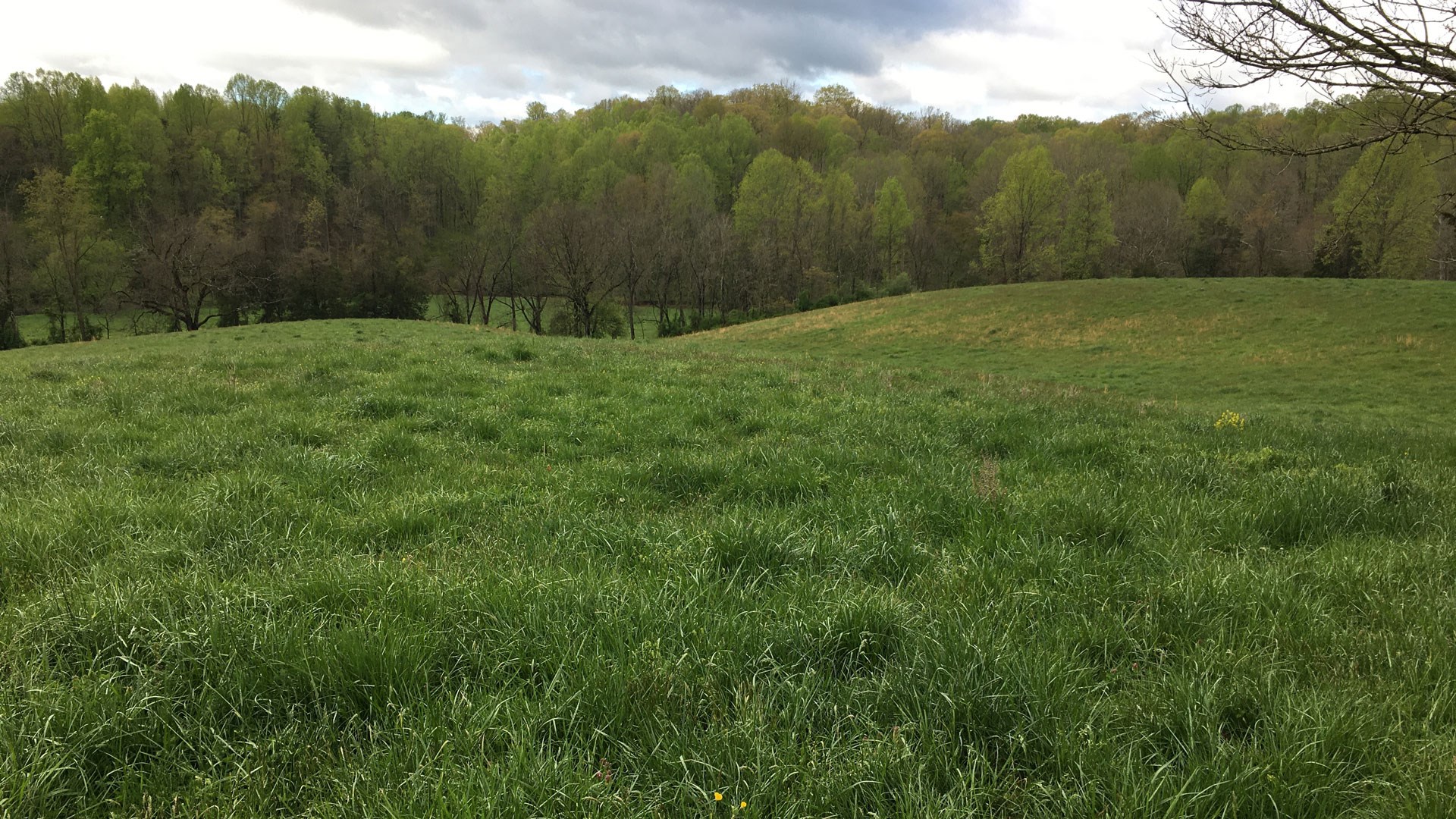
Can you kill a bird without having set foot onto the property that you’ll be hunting? Sure, but it’ll be more difficult. A better choice is to visit the location and, without disturbing the birds, identify roosting locations (best achieved at dawn and dusk), dusting sites and preferred strut zones. Besides using binoculars to identify bird movement and patterns from a distance, well-placed trail cameras can be immensely helpful, as you can see when and where the birds are. Is it a dealbreaker if you walked into a flock? Nope. My most challenging gobbler to date was killed in the exact location that I bumped into it and its hens about a month and a half earlier.
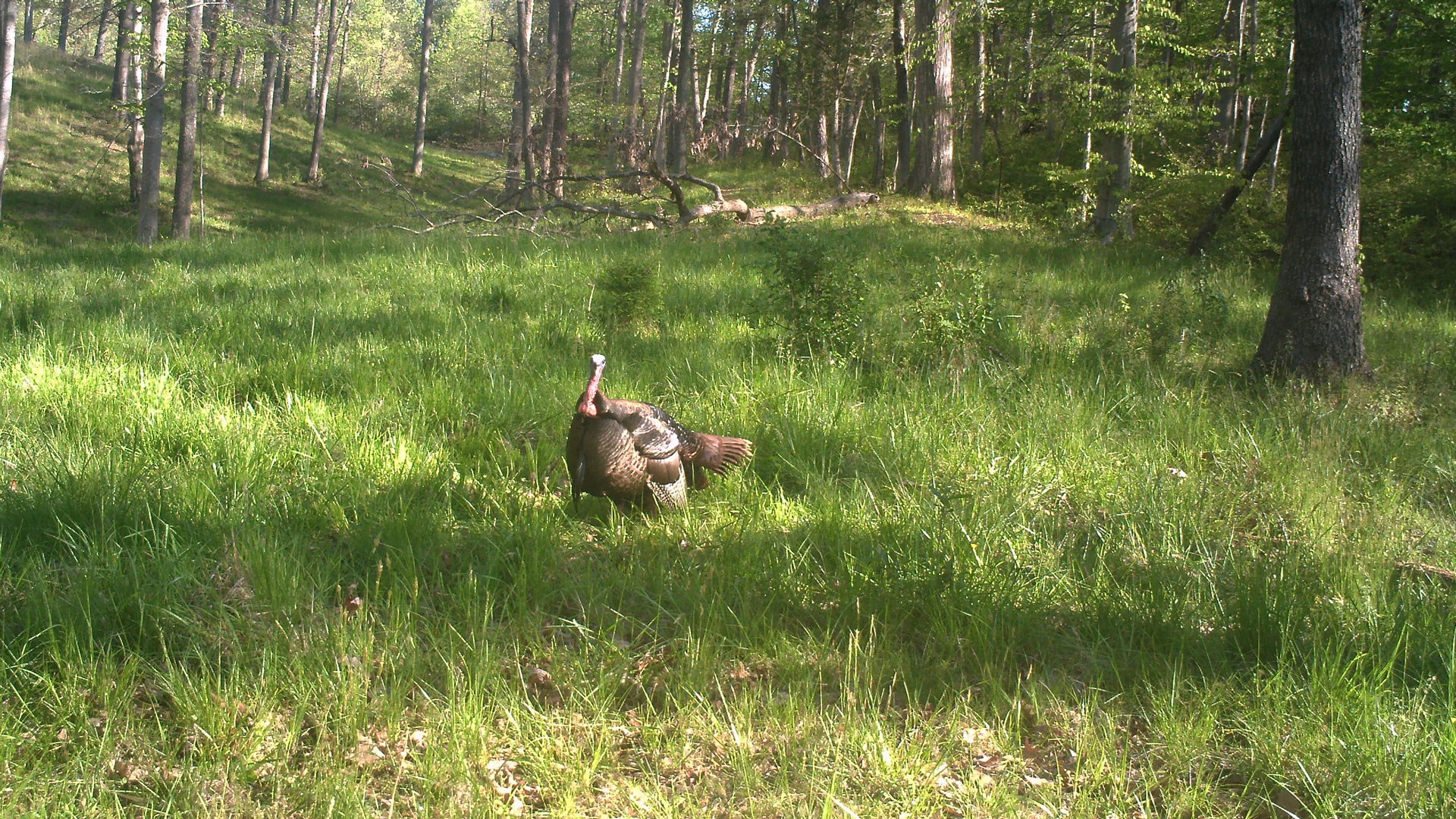
Provided that they’re unmolested, gobblers often follow similar routes; however, distribution of food, predators and hunting pressure, not to mention movement of hens, can affect where they go daily. Key is finding where they want to be and setting up there, or along that route. Even the best calling and setup cannot sometimes not deviate a gobbler from the destination he has in mind. Scout to determine his preferences and use them to exploit him.
While looking for turkey sign, take stock of the terrain. Depressions, hills, waterways (especially with high banks), trails and other physical features that’ll allow you to move quickly and unnoticed from a gobbler—especially one still roosted early in the season, when the trees are devoid of leaves—are critical to know.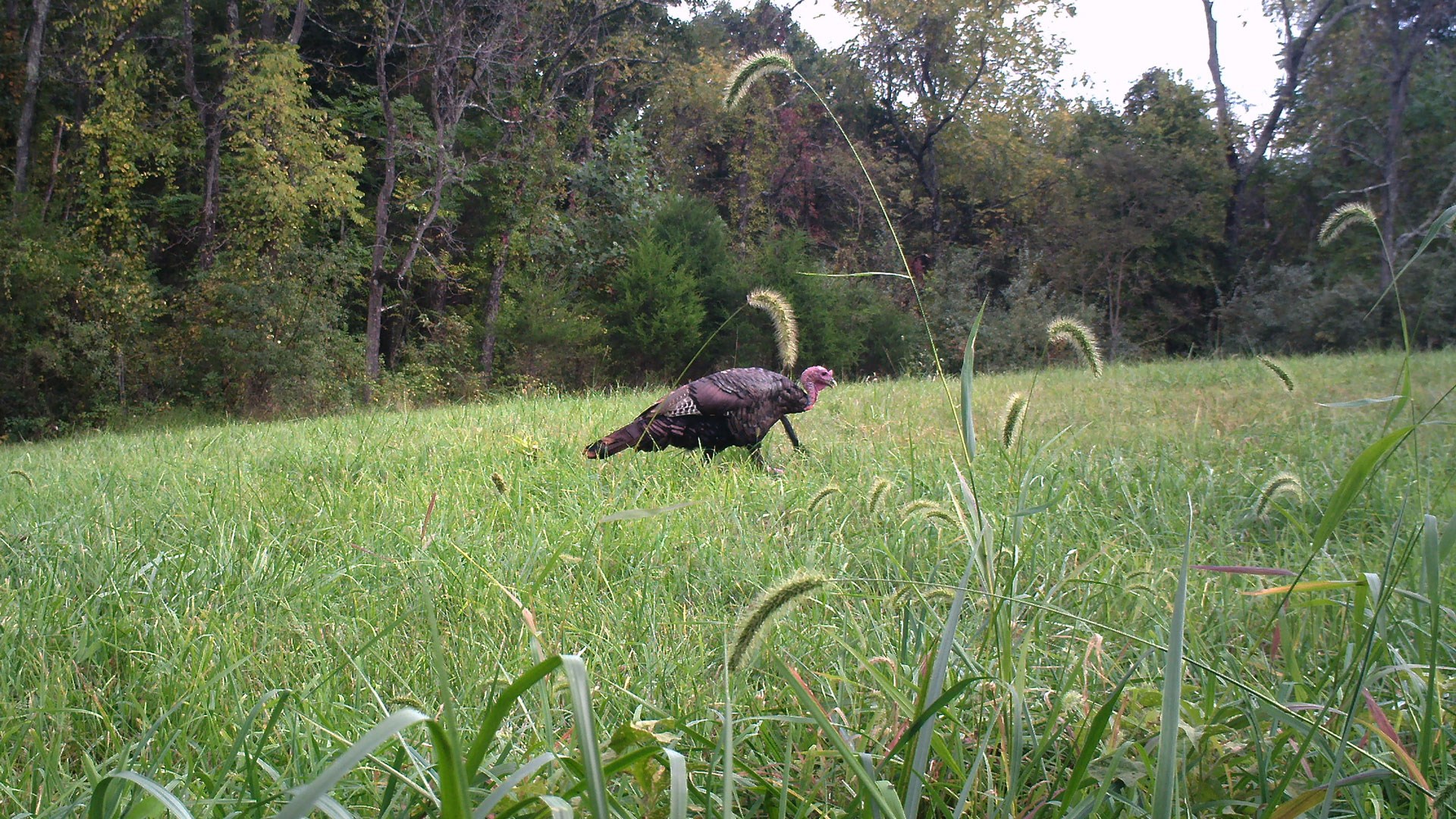
With the above knowledge, you’ll know where to start your adventure, the gobbler’s likeliest route, as well as the best routes of travel and alternative set ups. The homework is done; now it’s test time.
Game On
Volumes have been written about spring turkey hunting, so I cannot cover it all here. But I will provide a synopsis. I will suppose that you’ve been scouting, so you’re acquainted with your quarry’s habits and habitat.

Preferably, you’ve observed and/or listened to where the gobbler will start his day. This is easily pinpointed at dusk the previous evening; unless frightened, rarely would one change its location overnight. Provided that you have this intel, you want to set up between the tom and destination, or at its objective. It’s important that, if you’re expecting to connect shortly after fly down, you move in the dark—sans lights—and as quietly as possible, while using the terrain to prevent the gobbler from seeing you. Be aware that tom might not be alone. Unseen hens and approaching too close are sure ways to ruin a hunt in a hurry. Don’t try to get too close; let your calling do the labor. If you end up between the gobbler and its hens, it can be a slam dunk.
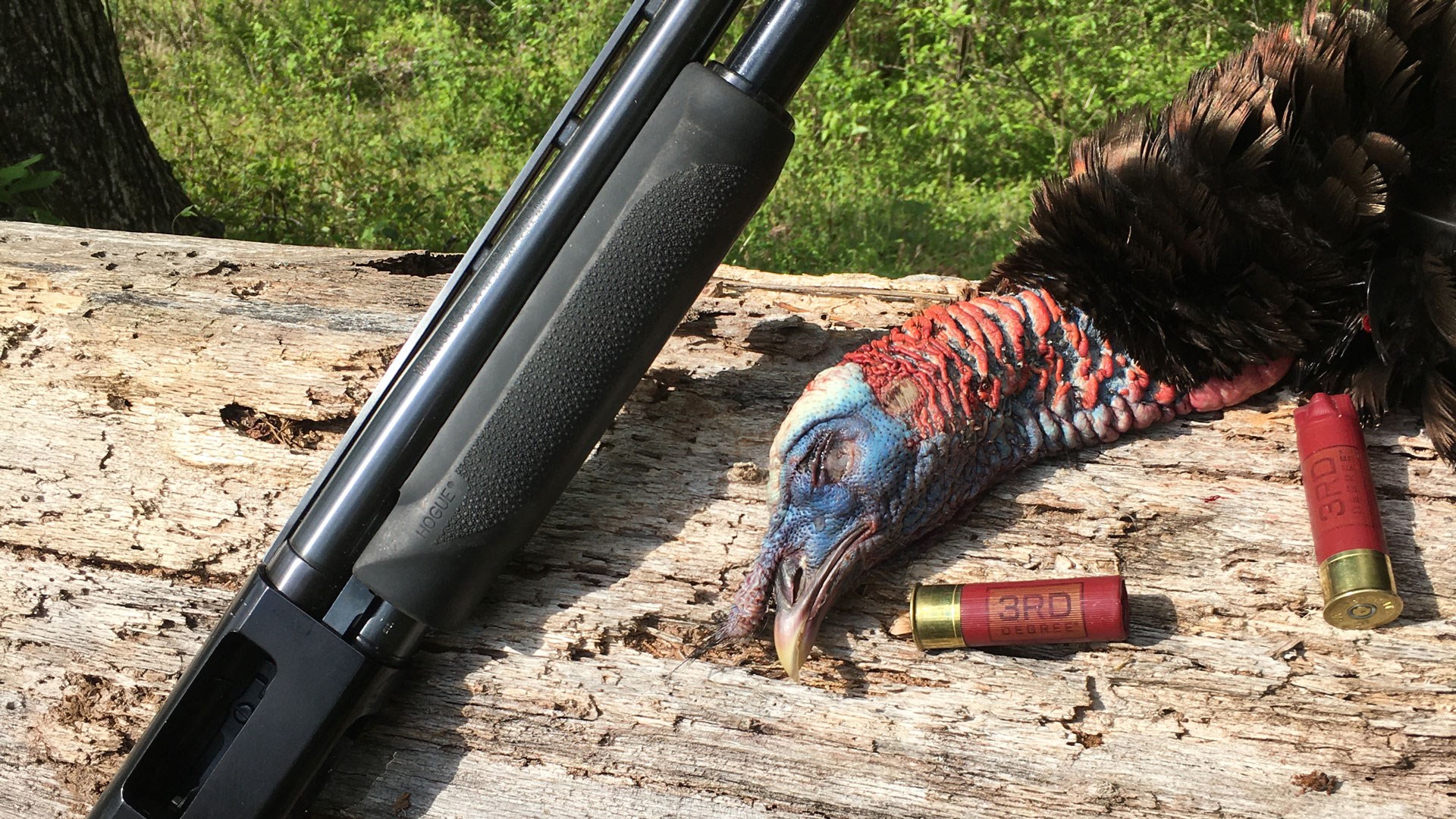
If I’m hunting mountainous terrain, I try to get above the gobbler; it’s not a hard-and-fast rule, but I’ve generally found that I’m more successful when calling them uphill. Otherwise, I’ll simply find a spot that gives me an uninterrupted view of where the gobbler is expected to approach from. Make sure that you have a clear shot. Don’t be surprised if it approaches from some other direction, or unseen subordinate birds approach silently. Be ready.
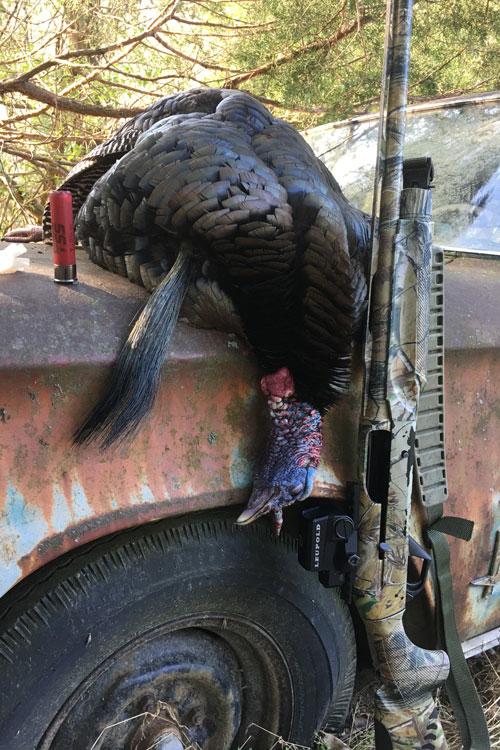
If you have a decoy and feel it’ll be helpful, now’s the time to set it—again, quietly. Note its distance—around 20 to 25 yards is good—and use it for reference. Then, clear out the leaves from your chosen seat. I use the HS Strutt blind material and sticks/branches to interrupt my silhouette (as viewed from the front). Make sure you’re comfortable, as you might have to wait out the gobbler. Ensure your back is against a tree larger than your shoulders. This protects your back from an unseen hunter and helps break up your outline.
When the woods begin to wake and the gobbler first sounds off, I like to make a few subtle tree yelps. This lets the gobbler know that a hen is there. If he responds, that’s a great sign. I may do this a few more times before stopping. When visibility increases and I believe the turkeys are closer to flying down, I’ll yelp with increased volume. His reaction tells me volumes. If the gobbler responds immediately, he’s likely to fly down and approach. I will often throw in a few extra yelps and fly-down cackle, for good measure. I then hush and let the gobbler make his move. Oftentimes, the gobbler will land somewhere between his roost site and you, then approach. Sometimes they’ll gobble non-stop in route, or they might be totally silent. Don’t mistakenly assume that, because it’s suddenly quiet, the gobbler is gone—quite the contrary. At times I will add in cutts, clucks, purrs and other turkey sounds, but they’re beyond the scope of this article. As you advance, you’ll want to familiarize yourself with these sounds.
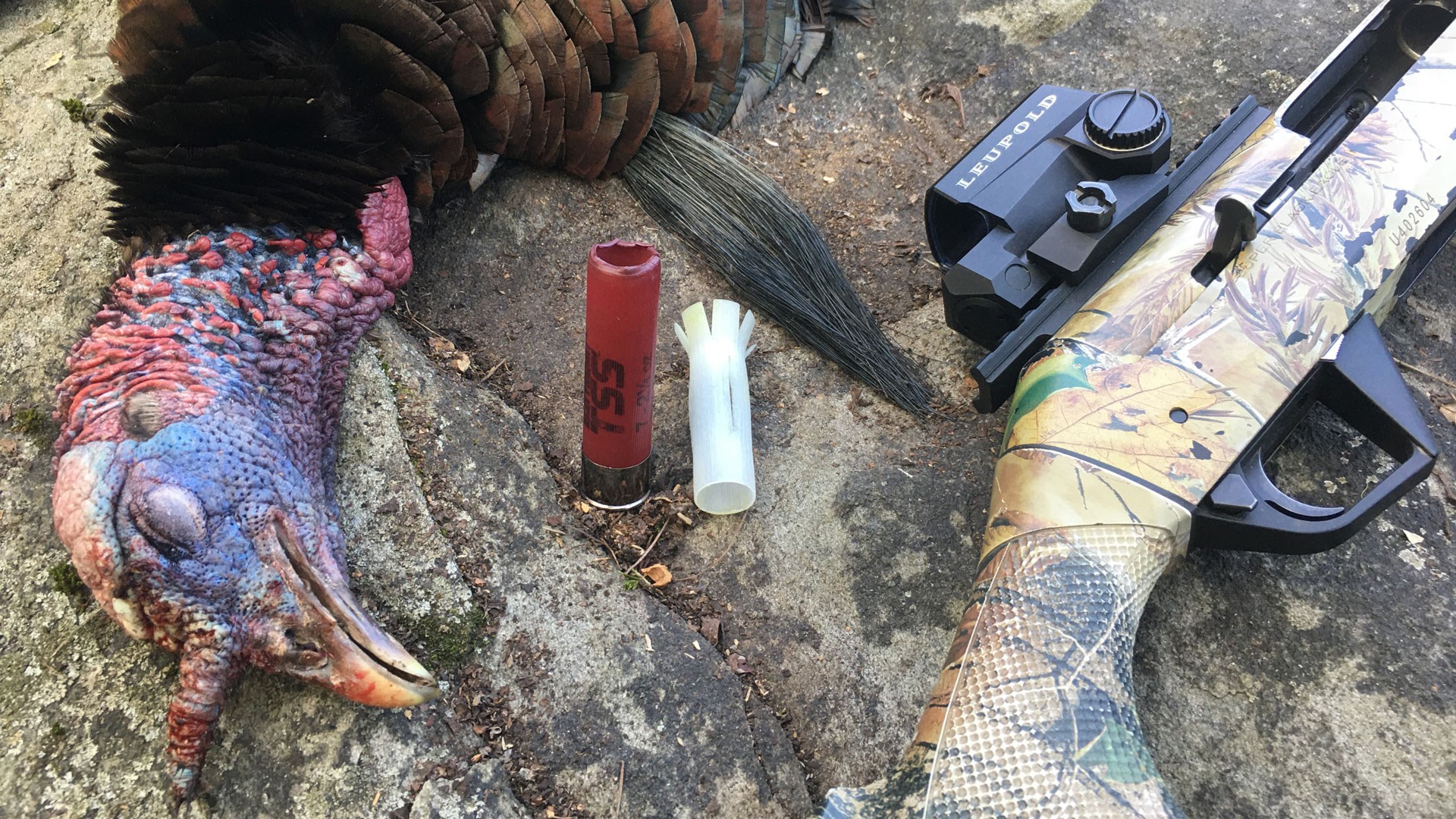
Should the gobbler not show in a reasonable amount of time, as he’s following hens or going elsewhere (you hear the gobble getting more distant), you’ll likely want to get up and reposition to intercept him. Don’t. If you’ve done your homework, you’re where the tom wants to be or will pass. And if he’s responded, the gobbler knows that a hen is there. A longbeard will return, believe me. It might take a while—even hours—but he will be back to find that hen. The tom just might need to breed live hens before doing so. Patience is essential to success.
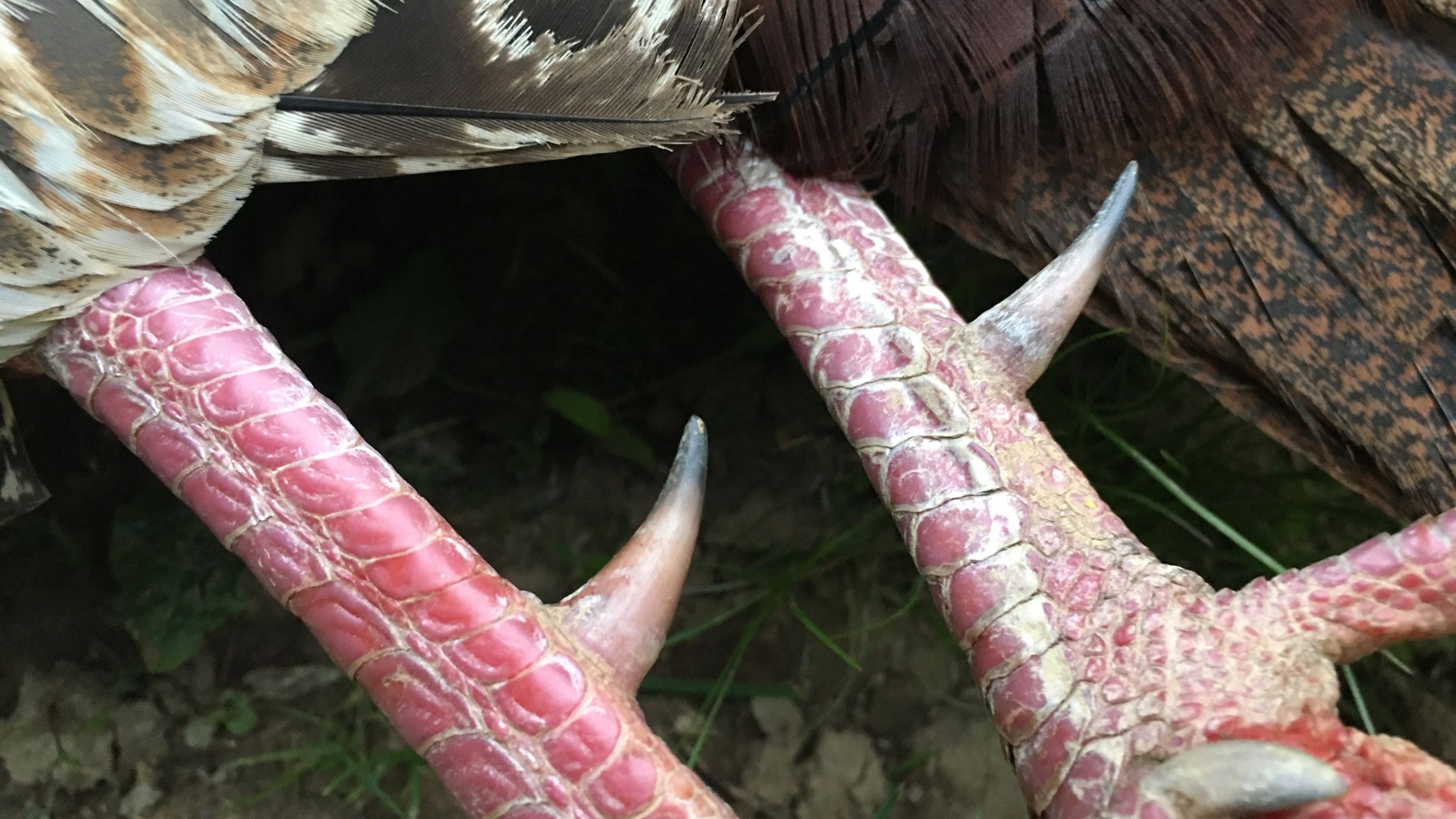
If you cannot hunt at first light, don’t fret; I’ve killed many birds mid-morning to later in the afternoon. In fact, it’s sometimes easier, as the gobblers have lost their hens and are actively looking for replacements. Just make sure that you’re hunting legal hours in your state. When hunting said hours, you’ll need to locate the gobblers. To do so, I use a combination of glassing and calling. Concerning the latter, I’ll ease along trails, field edges and truck/tractor paths through the woods, and use my louder calls. I prefer to do so before cresting hills, as the bird can be just on the other side, and it could be spooked if you proceed too fast. Been there, done that. Take your time. If you locate a gobbler, set up as you would any other time. Since the gobbler is without a hen and seeking, the approach can be fast.
Few types of hunting are as exhilarating as turkey hunting, and you’ll never stop learning. Gobblers will make sure of that. Put into practice what is discussed in this article, and you’ll be on your way to bagging your first tom, and hopefully one of many to come. Good luck.
